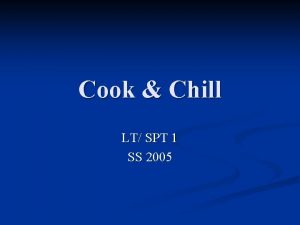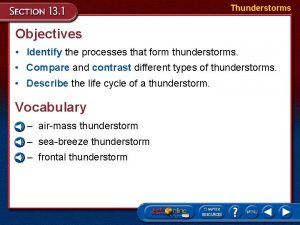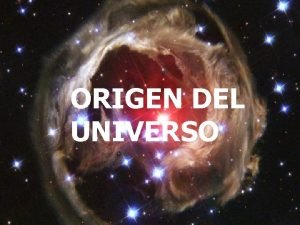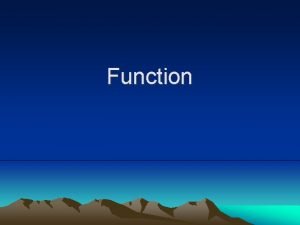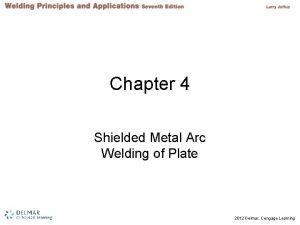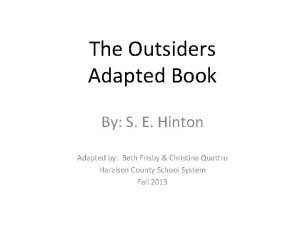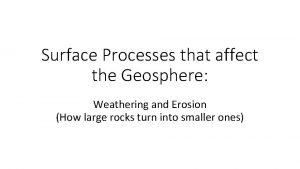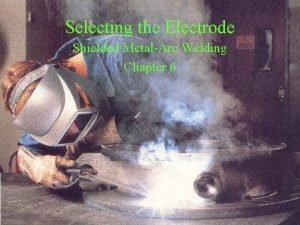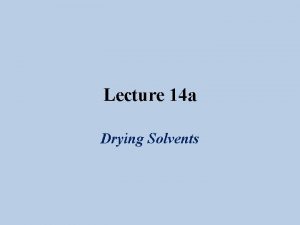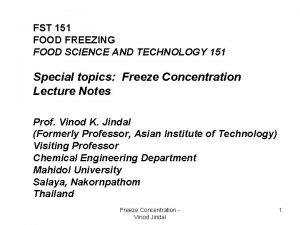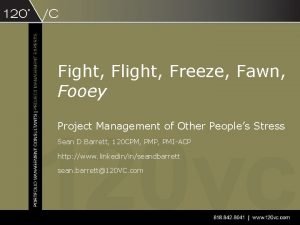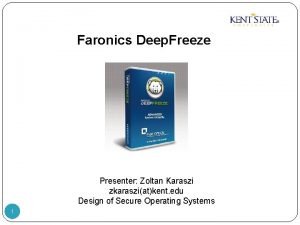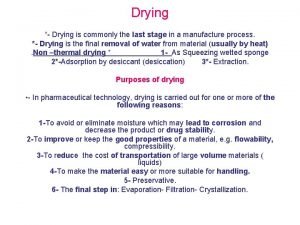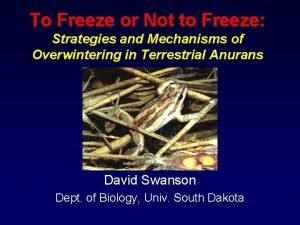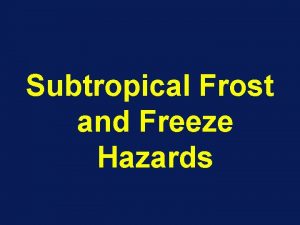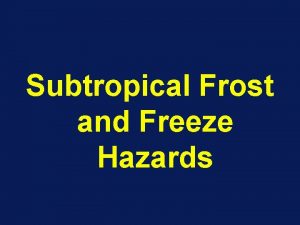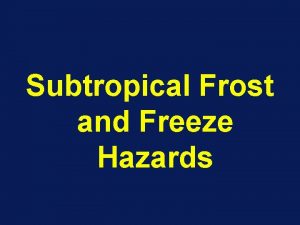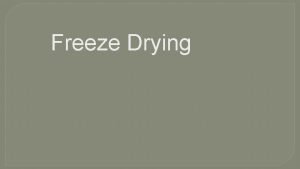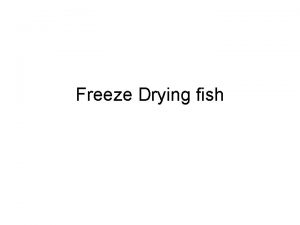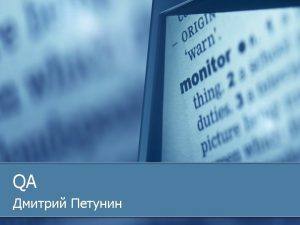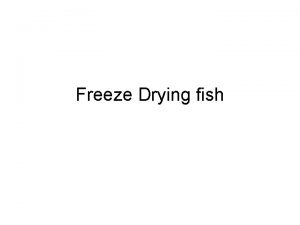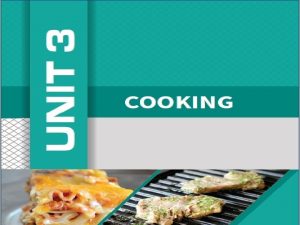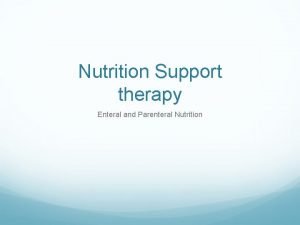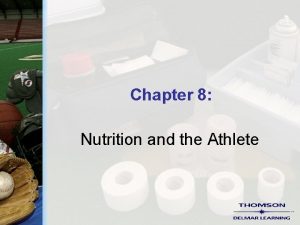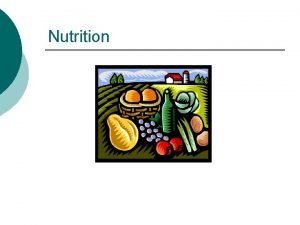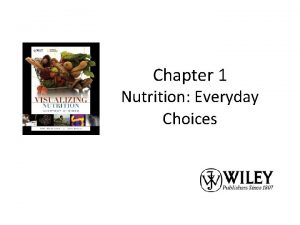NUTRITION L 3 COOK CHILL and COOK FREEZE




















- Slides: 20

NUTRITION L 3 COOK & CHILL and COOK & FREEZE SYSTEMS Gilbert Noussitou 2006 3 -1

Cook & Chill – Cook & Freeze • • Both systems are similar; designed to safely and efficiently pre-cook large quantities of foods The most important step is rapid cooling or freezing to prevent growth of microorganisms Gilbert Noussitou 2006 3 -2

Raw Materials • Buy from reputable suppliers. • Choose good quality products. • Raw materials should be prepared in areas separated from cooking and post cooking areas. Gilbert Noussitou 2006 3 -3

Cook & Chill Preparation Cooking Storage Portioning Rethermalization Chilling Gilbert Noussitou 2006 Service & Distribution 3 -4

Cook & Chill Basic Concept • • • Foods are prepared using traditional cooking methods, Foods are quickly chilled to 0°C to 3°C (32°F to 37°C) Foods are refrigerated and reheated for service within 5 days Gilbert Noussitou 2006 3 -5

Cook & Chill Basic Concept • The key component of this system is the blast chiller; capable of cooling foods in no more than 90 minutes Gilbert Noussitou 2006 3 -6

Cook & Chill Basic Concept • The rate of chilling is influenced by the size, shape, density, weight, moisture content & temperature of the food Three methods: • – – – Cold air circulated at high speed (most common) Non-oxidizing gases (less common) Cold liquid (not common) Gilbert Noussitou 2006 3 -7

Cooking • The core temperature of food must reach 71°C (160°F) & should be held at this temperature for no less than 2 minutes. • Check the temperature using a probe thermometer inserted into the slowest heating point, normally the center. Gilbert Noussitou 2006 3 -8

Portioning • Most menu items are placed on trays no more than 50 mm (2”) deep • Large pieces of meat etc. , may not chill as quickly as required; the meat should be portioned while hot in packages of 2. 5 kg (5 lbs) maximum and no more than 100 mm (4”) thick and then chilled. Gilbert Noussitou 2006 3 -9

Blast Chill • The rapid chilling process must begin within 30 minutes of cooking being completed. • Once in the chiller, the food must be chilled to a core temperature of between 0°C & 3°C (32°F & 38°F) within 90 minutes. • Alternatively, the temperature of large joints of meat must be reduced to 10°C (50°F) or below within 150 minutes, and then portioned before final chilling to 0°C & 3°C (32°F & 38°F). Gilbert Noussitou 2006 3 -10

Blast Chill • The speed at which chilling takes place will be affected by the shape, size and density of the food, its moisture content, heat capacity and entry temperature. • Placing lids on containers or stacking them on top of one another, will increase the chilling time. • However, covering food can protect against contamination, and is thus sometimes appropriate, as long as chilling can still be achieved within the time limits. Gilbert Noussitou 2006 3 -11

Blast Freeze • The rapid freezing process must begin within 30 minutes of cooking being completed. • Once in the freezer, the food must reach a core temperature of at least -5°C (23°F) within 90 minutes, and a subsequent temperature of at least -18°C (0°F). Gilbert Noussitou 2006 3 -12

Storage: General Rules • Cook/chill food should be stored in a cabinet or chamber designed for that purpose. • All food should be clearly marked with a description, production date and expiration date. • A stock rotation system should be enforced (FIFO). Gilbert Noussitou 2006 3 -13

Storage: Chilled Food • Pre-cooked chilled food should be stored between 0°C to 3°C (32°F to 38°F) for a period up to 5 days. • If storage temperature rises over 4°C (40°F), but no more than 10°C (50°F), the food should be consumed within 12 hours. • Should any food in the store exceed its expiration date or reach a temperature over 10°C (50°F), it should be thrown out as it will be unfit for consumption. Gilbert Noussitou 2006 3 -14

Storage: Pre-Cooked Frozen Food • Pre-cooked frozen food should be stored at -18°C (0°F) or below. • Generally, frozen food may be stored for up to 8 weeks, although certain food can be stored longer Gilbert Noussitou 2006 3 -15

Distribution • Frozen foods must be transported to the rethermalization site in controlled conditions. • If a product starts to thaw, it must not be refrozen. Gilbert Noussitou 2006 3 -16

Thawing • Pre-frozen foods must be fully thawed before regeneration. • Thawing must be controlled preferably with the use of a controlled thawing cabinet. • Food thawed rapidly in fast thaw cabinets should be consumed within 24 hours. • Thawed food must not be refrozen. Gilbert Noussitou 2006 3 -17

Reheating Equipment • Appropriate reheating equipment, includes forced air, steam convection ovens and special chill/reheat carts. • Traditional types of hot-air ovens may be used, but care must be taken to ensure that exposed areas of food do not become dehydrated. • Commercial microwave ovens may also be used, and recommended for the rethermalization of individual or small numbers of meals. • Ideally, it is preferable to install matching rethermalization equipment. Gilbert Noussitou 2006 3 -18

Reheating (Rethermalization) • Cooked and chilled foods that are to be eaten cold should be consumed within 30 minutes after removal from storage. • Reheating must take place close to the point of consumption. • The core temperature of the food must reach 71°C (160°F). and be held at this temperature for at least 2 minutes. • Reheated food that has cooled should be destroyed. • Reheated food should not be refrozen. Gilbert Noussitou 2006 3 -19

Service • Once food has been reheated to the required temperature, it should be consumed as soon as possible, and preferably within 15 minutes of reheating. • The core temperature of the food should not be allowed to fall below 65°C (150°F). Gilbert Noussitou 2006 3 -20
 Cook and chill svantaggi
Cook and chill svantaggi Garverfahren kochen definition
Garverfahren kochen definition Compare and contrast cold wave and wind chill factor
Compare and contrast cold wave and wind chill factor Good boys do fine always
Good boys do fine always Mapa conceptual de las galaxias
Mapa conceptual de las galaxias A great teacher sings
A great teacher sings Who is betty's dad in the crucible
Who is betty's dad in the crucible Wind chill chart
Wind chill chart The chill project
The chill project Welding bead patterns
Welding bead patterns Past participle knit
Past participle knit Who does ponyboy talk to at the tasty freeze
Who does ponyboy talk to at the tasty freeze Mechanical and chemical weathering
Mechanical and chemical weathering Fast fill electrodes
Fast fill electrodes Mix freeze group
Mix freeze group Freeze drying solvents
Freeze drying solvents Freeze pump thaw degassing
Freeze pump thaw degassing 151 food
151 food Fight flight freese
Fight flight freese How to open deep freeze configuration administrator
How to open deep freeze configuration administrator Principles of freeze drying
Principles of freeze drying

